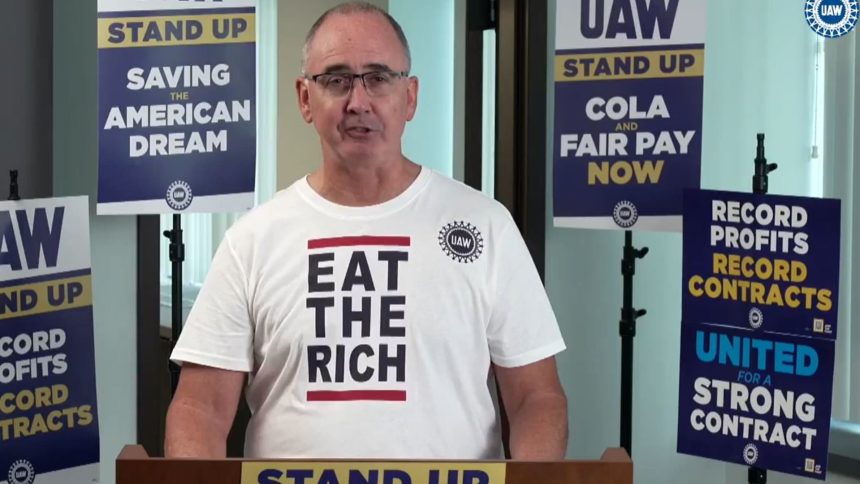DETROIT – The United Auto Workers will not expand strikes against the Detroit automakers this week amid progress in the talks, including General Motors agreeing to include battery cell workers under the company’s national agreement.
This is the first week since targeted strikes by the UAW started on Sept. 15 that the union will not expand the work stoppages at GM, Ford Motor or Chrysler-parent Stellantis.
Fain said the union was planning to shut down GM’s Arlington Assembly plant that produces highly profitable full-size SUVs until a last-minute proposal by the company to place the automaker’s battery cell workers under its national agreement.
“Just that threat has provided a transformative win,” Fain, wearing an “EAT THE RICH” T-shirt, said during an online broadcast Friday. “We’ve been told for months that this is impossible … and now we’ve called their bluff. What this will mean for our membership cannot be understated.”
GM declined to immediately comment on the battery cell workers, citing the ongoing negotiations: “Our goal remains to reach an agreement that rewards our employees and allows GM to be successful into the future.”
GM, with its battery plant in Ohio, is the only Detroit automaker with a joint venture battery plant in operation and unionized in the U.S. The automaker has announced plans for two other U.S. battery cell plants with LG Energy Solution as well as one with Samsung SDI.
Battery plants
GM’s agreement will put pressure on crosstown rivals Ford and Stellantis to do the same, as the UAW tends to pattern agreements off one another for members to receive “equal pay for equal work,” a longstanding motto of the union.
“The plan was to draw down engine and transmission plants and permanently replace them with low-wage battery jobs,” Fain said. “We had a different plan, and our plan is winning at GM. And we expect it to win at Ford and Stellantis as well.”
Electric vehicle battery plants have been a major point of contention in this year’s talks between the union and the three Detroit automakers. Each automaker has formed joint ventures with battery makers to manufacture EV batteries in the United States — a move the union has characterized as a plan to shut it out of the new factories, many of which are under construction now.
Officially, because they’re owned by joint ventures, the battery plants aren’t covered by the automakers’ agreements with the union. The automakers have said that because of that status, the plants shouldn’t be a factor in contract negotiations with the union.
But the UAW has made a “just transition” — meaning, a plan to protect their members as the industry shifts to electric vehicles — a centerpiece of this year’s negotiations, something that has frustrated the automakers. Ford CEO Jim Farley said last week that the UAW is “holding the deal hostage over battery plants.”
Ford declined to comment following Fain’s comments Friday, referring to a statement issued earlier in the week that the company remains “open to the possibility of working with the UAW on future battery plants in the U.S., reminding that these are multibillion-dollar investments and have to operate at sustainably competitive levels.”
Fain said in his Friday presentation that the union had expected to announce an expansion of the strike against GM. “But today, because of our power, GM has agreed to lay the foundation for a just transition,” he said.
‘Significant progress’
UAW has been gradually increasing the strikes since the work stoppages began, after the sides failed to reach tentative agreements by Sept 14. The targeted, or “stand up,” strikes are taking place instead of national walkouts in which all plants simultaneously strike.
“I wish I were here to announce a tentative agreement at one or more of these companies, but I do want to be really clear: We are making significant progress,” Fain said. “In just three weeks, we have moved these companies further than anyone thought was possible.”
Fain said Ford has offered a 23% raise over the life of the expected four and a half year contract, while GM and Stellantis are at around 20%. Stellantis and Ford also have agreed to reinstate a cost-of-living adjustment that the union lost more than a decade ago, among other enhanced proposals by each of the companies.
Stellantis North America Chief Operating Officer Mark Stewart, who’s overseeing the negotiations, said the sides “are making progress, but there are gaps that still need to be closed.”
“While we still have some work to do, I remain optimistic that our discussions are providing a pathway to a tentative agreement,” Stewart said.
Only 25,200 workers, or roughly 17% of UAW members covered by the expired contracts with the Detroit automakers, are currently on strike. Fain previously said the union would increase the work stoppages, based on progress in the contract negotiations.
The strikes began at an assembly plant for each of the Detroit automakers, followed by 38 parts and distribution centers for GM and Stellantis. A week ago, the union expanded strikes to assembly plants for GM in mid-Michigan and Ford in Illinois.
“We’ve been very careful about how we escalate this strategy,” Fain said.
Vehicle production impacted by the strikes include Ford’s Ranger midsize pickup and Bronco, Explorer and Lincoln Aviator SUVs; Stellantis’ Jeep Wrangler SUV and Gladiator small pickup; and GM’s Chevrolet and GMC midsize pickups, Chevrolet Traverse, Cadillac XT4 and Buick Enclave SUVs and Chevrolet Malibu sedan. The Malibu and XT4 production were idled due to parts shortages caused by the strike.
GM this week said the UAW’s strike cost it $200 million in lost production during the third quarter.
UAW negotiators have received counter proposals from each of the Detroit automakers during the past week, starting with Stellantis a week ago before Fain’s Friday strike announcement. Ford followed early in the with a proposal and then GM submitted a counteroffer Wednesday night.
Read the full article here




